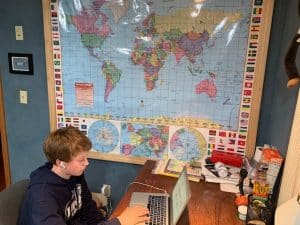Silver Linings: Observations of Self-Directed Behavior in an Online Environment
CompetencyWorks Blog
This article was originally posted on the New Hampshire Learning Initiative website.
There has always been a clear recognition of the importance of the critical competencies of communication, collaboration, creativity, and self-direction for success in the “real world” by teachers, parents, community members, and local business leaders. The “why” has never really been a question. However, providing opportunities for application of these skills in real-world situations that can transfer outside the walls of the school has been a question that educators have been grappling with.

Many educators in New Hampshire have been deliberately engaged in integrating the work study practices into learning experiences for the past four years. We always approached this work in classrooms through the lens of supporting learners in practicing these skills in school, in the hope that students would be able to apply these skills outside of school. A common starting point for schools coming into this work was to begin with self-direction with a focus on metacognition, the ability to be self-aware, set goals, and monitor and adapt. No one ever considered that a true test of self-direction and metacognition, and an opportunity for students to practice (and demonstrate) these skills would occur because of a global pandemic that necessitated distance learning.
Since this epidemic caused the shutdown of schools statewide in New Hampshire on March 15th, the New Hampshire Learning Initiative has sought ways to support educators in the field. During that first week, my wife and I balanced supporting our own children (ages 15, 14, and 8) with their schooling, while I considered on a professional level how I could support the field in some meaningful way. The idea of doing podcasts (something I had never done before) came about because we were speaking with many of our teacher, principal, and superintendent colleagues in the field who were sharing incredible stories of compassion, perseverance, and creativity. We thought that we could share these stories to help others. One of the common themes in these conversations, from the very beginning, was the teachers’ and building level leaders’ recognition of the role of self-direction, and the many surprises they were experiencing in relation to this.
Cathy Baylus, social studies teacher from Laconia Middle School, recently shared that “kids are proving me wrong.” The ones Cathy thought might be struggling were doing well, and some she thought would be fine were struggling. Jess Tremblay, Social Studies teacher at Souhegan High School, concurred with Cathy’s initial observation, noting that she saw almost immediately that “students who typically struggled with self-direction in the regular classroom were flourishing in this new environment.” It suggests that the environment plays a bigger role in the manifestation of these skills than we may have previously considered. Nicole Woulfe, noted recently that students had actually requested resources related to self-direction to utilize in their home environment. In a previous conversation with Nicole, (her school had been doing distance learning for less than a week at that point) she noted in this podcast (this portion begins at 7:04) that “students that do not present themselves as independent learners in the classroom, have presented themselves as independent learners at home”. Nicole described this as “super interesting”. I would agree.
In one of my early calls with Ryan McCluskey and Jill Lizier, principal and assistant principal (respectively) of Memorial School in Newton, NH, they note their school’s focus, and the students’ strengths in work study practices (portion beginning at 16:35), but Jill notes that this situation will “highlight the agency piece” and Ryan recognizes it is “going to show (them) what students are really able to do.” When we followed up with Ryan and Jill just recently, about three weeks after our initial call, they noted how their historical focus on CARES has really served students well in this environment, and in fact has become an entry point for the administration to engage in “facetime” with the entire student body. Recognizing that their instruction of these skills had always been geared toward the behaviors in school, Ryan and Jill share a Friday message focusing on various aspects of the CARES behaviors. The most recent message to their students, linked here, is on Assertion, a correlating component to self-direction.
Classroom teachers as well, very early on, recognized the role that self-direction and metacognition would play in this new normal. Jennifer Manning, a kindergarten teacher at Memorial School in Newton, NH noted that her students (beginning at 5:31), developmentally, need a greater level of support. Jennifer had to be cognizant of the availability of parents to support their children, given the students developmentally limited ability as five-year olds to be self-directed. The scaffolding and support at these primary ages is critical.
This recognition of the need for structure was not limited to primary-age classrooms, however. Heather Wheeler, Sanborn Regional High School Science Teacher noted that “all children… need structure” and they had “quickly come to consensus (as a staff) that they wanted their students to have structure in their (virtual) day” and built a schedule accordingly, especially at the beginning of their transition. It intentionally included face-to-face time with ongoing opportunities for students to check in. Ashley Harbel, Sanborn Regional High School ELA Teacher also noted the “checkpoints” that they are providing for students “who need a little more structure”. Teachers, as they do in their physical classrooms, are providing the scaffolds and supports at all levels to ensure the greatest opportunities for success.
The current situation is unprecedented, and has prompted some students who maybe haven’t asserted themselves with their teachers in a typical classroom in the past to begin to do so. Bari Boisvert, Sanborn Regional High School ELA teacher (beginning at 6:45), shared that students that she didn’t hear from typically “have been emailing and asking if they can set up an (individual) Zoom.” This opportunity has allowed for a more personal check-in, to address school-related issues, but also connect on how the students are doing. This connection, however, may not have happened had the student not taken the initiative to reach out.
Additionally, the structure of the school day looks very different for everyone, teachers, parents, and students alike. Ashley Harbel noted this in her podcast, when she shared how she has recognized the need to stay flexible (beginning at 11:40), as some of her students are getting their work done, but not during the day, as they are having to assist younger siblings, or in some cases, out of necessity, work during the day because there is a family need. The bottom line is that when students have the support (and are afforded flexibility and options for work completion) that they need, they can be successful while “taking care of the things they need to take care of” but still having the leeway to be self-directed in determining how they can get done what needs to get done academically.
It has also become clear that the self-direction and work study practices work happening in classrooms prior to the move to distance learning has served students well during this difficult time. Sarah Kiley, Art Teacher from Epping High School, (beginning at 10:59) has utilized previous work she had done around work study practices as a foundational component for her move to distance learning. Sarah noted that she was able to keep things somewhat consistent during their initial move to distance learning because there were some work study practice assignments (blog posts) that were already due, and students in this new environment chose to talk about avoiding procrastination, using shorter term goals, and modifying schedules to ensure their work was getting done. This is a direct reflection of metacognitive practices being utilized and transferred, a critical component to demonstrating mastery. Sarah noted “the benefit of being able to demonstrate these skills when no one is watching.”
Through all of this, a curiosity is brewing about how this situation may have a lasting impact on students’ metacognitive and self-direction skills. Brian Stack, Principal of Sanborn Regional High School, (beginning at 11:00) shared that a “lightbulb went off for (Brian) as he was reflecting upon the previous three weeks. Despite the fact that we were all “thrown into this environment”, and “security blankets” of support were removed, “we’re all being forced to think about work study practices in a new way.” Brian recognizes the potential for a “silver lining” and is “cautiously optimistic” that students will “come back to schools with a much better understanding of how they learn, of what they need to learn, of how to start the learning process, and be more independent, but also recognizing what they need more help with and how to advocate for that a little bit better.” In essence, metacognitive practices will possibly be more ingrained in the day-to-day thinking of learners.
Self-direction translating to an online environment is something my wife, Stephanie, and I have recognized in our own home, as well. As I mentioned at the beginning of this article, we have three children. Our oldest son, Garrett, is in eighth grade, and was thrust into this new mode of learning like so many others. I’ve had a number of conversations about self-direction with him, along with our other two children over the past two years (probably much to their chagrin), as the work I’ve done has allowed me the opportunity to reflect and think about the critical importance of these competencies and consider what may have helped me when I was a student. I was very pleased to walk into Garrett’s room last week and find a crumpled up piece of paper on his desk, with a clear weekly schedule he had created to help him. When I asked him about this, he indicated that it was “what he needed to make sure (he) got everything done.” Over the course of the week, he methodically worked through this schedule, completing all of the work he needed to.

The long-term impact of our current situation as it relates to self-direction in students is yet to be determined. Drew Szeliga, STEM teacher at North Hampton School, noted in a recent conversation the opportunity this situation may present for teachers moving forward, In reflecting on how some students are doing well, while others may struggle, Drew wondered about what “we can bring forward to the next school year” by asking “what have I been doing well teaching self-direction and independence, and how can I improve that moving forward into future school years?” Sarah Kiley, noting an observation of her students’ recognition of these skills during this crisis shared that, “They (students) understand that these skills are serving them in their life and their ability to get work done and be proactive about seeking help when they need it. They’re much more self-reliant, and they’ve found a greater reason to demonstrate these work study practices then we could have ever imagined. They’re really showing it outside of the classroom.” If this recognition by teaching and students of the importance of self-direction occurs, and students are consistently able to transfer this skill in new situations, we may be able to point to these times as a turning point in our quest to prepare students for a world that requires these critical skills.
References:
Voices From the Field with Jonathan Vander Els: Ashley Harbel. Accessed at: https://motivis.org/voices-from-the-field-with-jonathan-vander-els-ashley-harbel/ on April 6, 2020.
Voices From the Field with Jonathan Vander Els: Bari Boisvert. Accessed at: https://motivis.org/voices-from-the-field-with-jonathan-vander-els-bari-boisvert/ on April 6, 2020.
Voices From the Field with Jonathan Vander Els: Brian Stack Revisited. Accessed at: https://motivis.org/voices-from-the-field-with-jonathan-vander-els-brian-stack-revisited/ on April 8, 2020.
Voices From the Field with Jonathan Vander Els: Heather Wheeler. Accessed at: https://motivis.org/voices-from-the-field-with-jonathan-vander-els-heather-wheeler/ on April 3, 2020.
Voices From the Field with Jonathan Vander Els: Jennifer Manning. Accessed at: https://motivis.org/voices-from-the-field-with-jonathan-vander-els-jennifer-manning/ on April 2, 2020.
Voices From the Field with Jonathan Vander Els: Ryan McCluskey and Jill Lizier. Accessed at: https://motivis.org/voices-from-the-field-with-jonathan-vander-els-ryan-mccluskey-and-jill-lizier/ on April 2, 2020.
Voices From the Field with Jonathan Vander Els: Ryan McCluskey and Jill Lizier Revisited. Accessed at: https://motivis.org/voices-from-the-field-with-jonathan-vander-els-ryan-mccluskey-and-jill-lizier-revisited/ on April 10, 2020.
Voices From the Field with Jonathan Vander Els: Sarah Kiley. Accessed at: https://motivis.org/voices-from-the-field-with-jonathan-vander-els-sarah-kiley/ on April 9, 2020.
Voices From the Field with Jonathan Vander Els: Nicole Woulfe. Accessed at: https://motivis.org/voices-from-the-field-with-jonathan-vander-els-nicole-woulfe/ on April 6, 2020.
Stack, B. and Vander Els, J. Opinion: Four effective strategies for parents who are now homeschooling their children. Hechinger Report. Accessed at: https://hechingerreport.org/opinion-effective-strategies-for-parents-new-to-a-homeschool-environment/ on April 9, 2020.
Learn More
- Highlighting Deeper Learning Competencies in New Hampshire
- The New Hampshire Learning Initiative: A Model for Catalyzing State-Wide Transformation
- Promoting Lifelong Learning Skills in the Classroom: New Hampshire’s Work Study Practices
 Jonathan Vander Els serves as a project director for the New Hampshire Learning Initiative, overseeing and participating in various projects related to personalized and competency-based learning throughout the State of NH. Formerly, Jonathan was principal of Memorial Elementary School in Sanborn Regional School District in New Hampshire. Under his leadership, Memorial School became a nationally recognized model PLC and competency-based learning elementary environment.
Jonathan Vander Els serves as a project director for the New Hampshire Learning Initiative, overseeing and participating in various projects related to personalized and competency-based learning throughout the State of NH. Formerly, Jonathan was principal of Memorial Elementary School in Sanborn Regional School District in New Hampshire. Under his leadership, Memorial School became a nationally recognized model PLC and competency-based learning elementary environment.
Jonathan specializes in supporting teachers and administrators in schools and districts in New Hampshire and across the country in developing, sustaining, and enhancing structures to support all learners. As a practitioner, Jonathan is able to blend his experience and expertise to meet educators where they are and assist them in developing practical next steps to ensure high levels of learning for students in their school.
Jonathan has consulted, coached, and presented at conferences and Institutes throughout the United States on building highly effective PLCs, implementing competency-based and personalized learning, and developing balanced and rigorous assessment systems. Jonathan is a Solution Tree Professional Learning Communities at Work Author and Associate, having co-written Breaking With Tradition: The Shift to Competency-Based Learning in PLCs at Work.
Jonathan has an education specialist degree from the University of New Hampshire in educational administration and supervision, a master’s in elementary education, a bachelor’s in history. Jonathan is currently enrolled at the University of New Hampshire in their Ph.D. Educational Leadership and Policy strand, with a focus on competency-based learning. Jonathan lives with his wife and three children on the New Hampshire Seacoast.